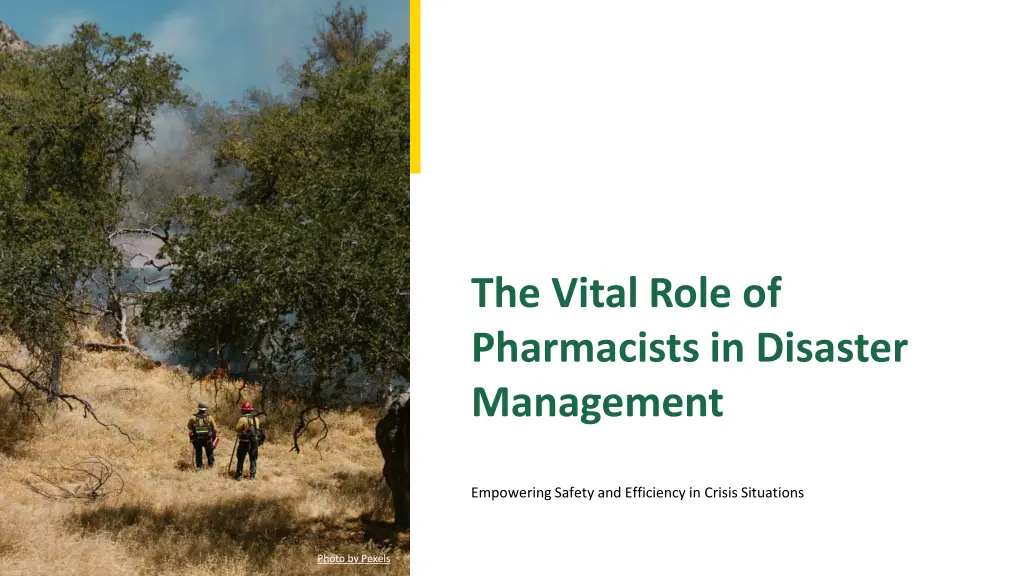
Pharmacists' Crucial Role in Disaster Management: Enhancing Safety and Efficiency
Discover the vital role of pharmacists in disaster management as they empower safety and efficiency in crisis situations. Explore topics such as developing workplace safety protocols, dispensing medicines, inventory management, identifying at-risk populations, and more. Learn how pharmacists contribute to mitigating the effects of natural and man-made disasters, ensuring readiness and preparedness for emergencies. Dive into case studies, challenges, and future directions in disaster management.
Download Presentation

Please find below an Image/Link to download the presentation.
The content on the website is provided AS IS for your information and personal use only. It may not be sold, licensed, or shared on other websites without obtaining consent from the author. If you encounter any issues during the download, it is possible that the publisher has removed the file from their server.
You are allowed to download the files provided on this website for personal or commercial use, subject to the condition that they are used lawfully. All files are the property of their respective owners.
The content on the website is provided AS IS for your information and personal use only. It may not be sold, licensed, or shared on other websites without obtaining consent from the author.
E N D
Presentation Transcript
The Vital Role of Pharmacists in Disaster Management Empowering Safety and Efficiency in Crisis Situations Photo by Pexels
01 Introduction to Disaster Management Table of Contents 02 Developing Workplace Training and Safety Protocols 03 Protocols for Dispensing Medicines 04 Inventory Management in Crisis 05 Identifying At-risk Populations 06 Communication and Coordination 07 Pharmacists as Public Health Advocates 08 Challenges in Disaster Management 09 Case Studies and Success Stories 10 Conclusion and Future Directions
1 Introduction to Disaster Management Understanding the Basics An overview of disaster management and its importance in mitigating the effects of naturaland man-made disasters. Exploring how pharmacists contribute to disaster management through medication management and public health support. Discussing the significance of being prepared for disasters and the role of pharmacists in ensuring readiness. Highlighting the need for pharmacists to work alongside other healthcare and emergency professionals. Photo by Pexels
2 Developing Workplace Training and Safety Protocols Ensuring Safety and Efficiency Steps to develop comprehensive training programs for pharmacists in disaster scenarios. Establishing safety protocols to protect pharmacists and patients duringdisasters. The importance of conducting regular drills to ensure preparedness and efficiency. Keeping pharmacists informed about the latest safety protocols and disaster management strategies. Photo by Pexels
3 Protocols for Dispensing Medicines Ensuring Access and Safety Developing systems to ensure quick and safe dispensing of medicines during disasters. Strategies to handle medicine shortages and ensure continuous supply. Providing essential counseling and support to patients during crises. Working with suppliers to maintain a steady supply of essential medicines. Photo by Pexels
4 Inventory Management in Crisis Maintaining Essential Supplies The importance of stockpiling essential medicines for emergency situations. Implementing systems for real-time tracking of inventory levels. Establishing efficient distribution channels to ensure timely delivery of medicines. Working with local authorities to manage inventory and distributioneffectively. Photo by Pexels
5 Identifying At-risk Populations Targeted Support and Care Identifying groups that are most vulnerable during disasters and require special attention. Developing healthcare solutions tailored to the needs of at- risk populations. Implementing outreach programs to educate and support vulnerable communities. Collaborating with NGOs to provide comprehensive care and support. Photo by Pexels
6 Communication and Coordination Ensuring Seamless Operations Establishing clear communication channels for efficient coordination during disasters. Working closely with emergency services to ensure a coordinated response. Leveraging technology to enhance communication and coordination efforts. Gathering feedback to continuously improve communication strategies. Photo by Pexels
7 Pharmacists as Public Health Advocates Promoting Health and Safety Educating the public on health and safety measures during disasters. Advocating for policy changes to improve disaster management and publichealth. Engaging with the community to promote health and safety awareness. Partnering with health organizations to enhance public health initiatives. Photo by Pexels
8 Challenges in Disaster Management Overcoming Obstacles Addressing the challenges of limited resources during disasters. Overcoming logistical challenges in the distribution of medicines and supplies. Navigating cultural and language barriers to provide effective care. Understanding and addressing the emotional and psychological impact on pharmacists and patients. Photo by Pexels
9 Case Studies and Success Stories Learning from Experience Examining case studies of successful disaster management involving pharmacists. Identifying key lessons learned from past disaster management experiences. Exploring innovative solutions implemented in past disaster scenarios. Sharing inspiring stories of pharmacists making a difference in disaster management. Photo by Pexels
10 Conclusion and Future Directions Looking Ahead Discussing how the role of pharmacists in disaster management is evolving. Exploring future challenges and opportunities in disaster management. Encouraging pharmacists to take an active role in disaster management. Sharing a vision for the future of pharmacists in disaster management. Photo by Pexels
